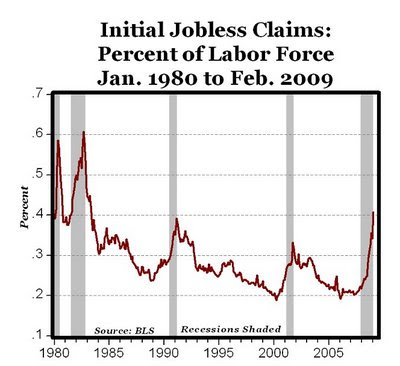
After repeatedly invoking the specter of the Great Depression to frighten the public into supporting the “stimulus” bill, the Obama administration has moderated its rhetoric. Professor Mark J. Perry of the University of Michigan offers statistics to show just how inappropriate it is to even talk about comparisons with the Depression:
The chart above shows the “initial jobless claims as a percent of the labor force” back to January 1980. To reach the same level as the peak in 1982 of 0.6067%, today’s jobless claims would have to be almost 936,000, or almost 50% higher than the current 628,000.
So how about we first get hysterical for awhile about the “worst economy since 1982” before we go totally hyperbolic about the “worst economy since the Great Depression.” Once we reach the 936,000 jobless claims it would take to equal the economic conditions of 1982, then let’s start talking about Great Depression II, but not before.
You might think, as I did, that initial unemployment claims is the wrong measure to use. Initial claims measures the velocity of the downturn, but surely total unemployment is a better measure of the full extent of the downturn. So I went looking for that data, and found that the most recent total unemployment rate of 8.1% is still well below the 9.7% rate of 1982. (Unemployment reached 25% at the peak of the Great Depression.)
Although we’re nowhere near a depression, the current recession probably has not hit bottom. In an interview televised yesterday, Fed Chairman Ben Bernanke said unemployment is likely to get worse before it gets better, but that he expects the recession to end “probably this year.”
